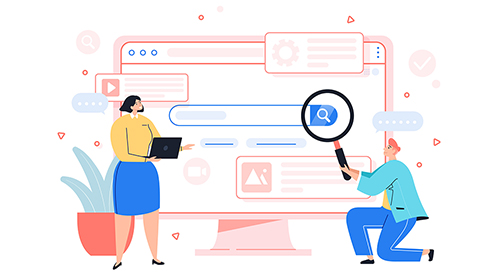It’s no surprise that businesses with good search engine optimization consistently outsell their competitors. Have you ever written what you thought was great content only to be shocked at how little people actually engaged with it? You can spend hours writing the most in-depth how-tos and knowledgeable blog posts, but if they aren’t aligned with your users’ intent, they will always fall short of the mark. Intent SEO is all about aligning your content to match your target audience’s intention in a given moment. Do they want to learn something, get somewhere or make a purchase? Where they are in the buyer’s journey also plays a role. You can craft content that guides buyers through different stages of the sales funnel and continue to satisfy them after they’ve converted. Let’s not get ahead of ourselves, though. To kick things off, let’s address the different search intent.
Types of Different Search Intent

Informational
This type of intent will require the most robust content, but it doesn’t always have to be lengthy to be effective. Someone searching for information about pet care might come across your blog post on the best types of dog beds, but that doesn’t necessarily mean they intend to make a purchase right now. What they’re looking for at this stage in the game is information, and that information can directly translate to your product’s value. Informational intent can come in many forms, including:
- Blog posts
- FAQ pages
- Customer knowledge bases
- How-to guides and walkthroughs
There’s an added benefit to writing high-ranking informational content, and that’s bolstered brand authority. When you come up as one of the most highly recommended sites, people are instinctively more likely to trust anything you say and believe your products/services are more reliable, too.
Different Search Intent – Transactional
People making transactional services have already decided they’re ready to buy something, so they don’t need to be convinced. Instead, they need to be directed to stellar service pages or product catalogs that immediately put them in touch with what they’re looking for. Here are some examples of transactional SEO searches:
- Buy leather couch
- Shop women’s winter puffy coats
- Designer boots sale
Usually, searches are tailored to brand names, but you can still rank higher in the search engines if you optimize your content for both the product name, type, and, if applicable, location. This ups your chances of being seen immediately by potential customers who are ready to act.
Different Search Intent – Navigational
Rather than type out a full URL by hand, most people search for whatever site and the web page they’re looking for. When’s the last time you actually typed www.facebook.com? You search the name of the platform or site you want and go from there. Navigational intent won’t be relevant for every business, but it still helps ensure that your website is well-structured. The easier it is for Google to crawl your site and index its pages, the more likely you will show up in search results for your targeted keywords. A good web structure also makes it easier for visitors to search and explore; you can design a website that guides people through the buyer’s journey rather than hoping ads magically turn them into loyal customers.
Commercial Investigation
Most people compare prices online before they make a final decision. They’ve already gathered enough info and are narrowing their options down. Reviews play a huge role in this stage, but there are also instances where keywords will help you show up more often. Local businesses should take note that many people come across their sites through commercial investigation. For example, searching “best plumbers Los Angeles” or “emergency vet near me” are examples of this type of intent.
5 Things to Consider When Optimizing Your Site for Different Search Intent
Now that you’re aware of how people use search engines to fulfill different purposes, we can explore five easy ways to start optimizing your web page. By incorporating intent SEO into your strategy, you can drive traffic and multiply revenue more every month. It takes time to find the right balance, but once you find yours, it becomes easy to match your content and website to your target audience’s various intents.
Revise for Intentional Keywords
Check out your current keywords and consider how they could be spun into an intent-based search. This framework makes it easier to come up with new ideas as well as structure your website. Examples of words to include are: how, when, who, where, when, guide, tutorial, walkthrough, resources, example.
You don’t have to include “who” to answer the question literally, and the same logic applies to the other keywords as well. Gather some insight on your consumers and see how most people have landed on your site thus far. You’ll have a better idea of where you’re performing well and what areas you need to improve from there.
Avoid Keyword Stuffing
Intent SEO takes some attention away from keywords and focuses more on context. It’s not just about putting 10 different variations of “how to unclog a toilet” or “how to make pizza at home” into your page. It’s about giving people what they want and what they’re looking for in a way that feels natural and, most importantly, works. Hone in on your audience’s needs and write the best possible content to fulfill that purpose. Think more about the context and value than a huge list of keywords.
Read SERPs for Your Industry
Take on the consumer’s role and explore the search engine result pages (SERPs) for the top results for intent searches. What pops up when you type “top restaurants in LA” or “family dentists near me”? Know your competition, explore their websites and see why they’re ranking higher than you. Only when you think and act like a consumer can you produce content that truly resonates with your audience.
Optimize Metadata
Your on-page content should closely align with optimized meta tags and descriptions for the best results. Make sure that your headers, especially h1s, are properly named and have a keyword-optimized title. Is this a how-to page? Is it answering something about a product’s use or features? Everything should have a purpose when you’re working with intent.
Work with a Professional
Depending on how much work you have to do, it can be beneficial to get an SEO analysis from a professional. You may be able to do all the work from there, but an expert’s personalized feedback can help you create a framework that leads to faster growth and greater sales.
